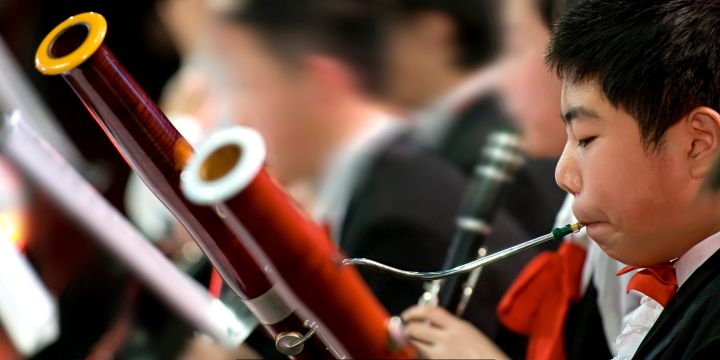The history of the warped bocal is a fascinating journey that intertwines the evolution of the bassoon with the artistry of woodwind instrument design. The bocal, a crucial component of the bassoon, serves as the connecting piece between the instrument’s body and the reed. Its design has undergone significant transformations since the bassoon’s inception in the early 17th century.
Originally, bocals were relatively straight and simple in form, reflecting the straightforward construction techniques of the time. As musicians began to explore the instrument’s capabilities, the need for a more nuanced design became apparent. By the 18th century, as composers began to write more complex and expressive music for the bassoon, instrument makers started experimenting with different shapes and materials.
The introduction of the warped bocal marked a pivotal moment in this evolution. This innovative design allowed for greater flexibility in sound production and articulation, enabling bassoonists to achieve a wider range of tonal colors. The warped bocal’s unique curvature not only enhanced the instrument’s playability but also contributed to its distinctive sound, setting it apart from other woodwinds.
Over time, this design became a staple among professional bassoonists, solidifying its place in the history of woodwind instruments.
Key Takeaways
- The warped bocal has a long history dating back to the 17th century, evolving from a simple metal tube to a complex and essential component of the bassoon.
- The unique sound of the bassoon is a result of the conical bore and the double reed, with the warped bocal playing a crucial role in shaping and amplifying the instrument’s sound.
- The warped bocal affects bassoon performance by influencing intonation, tone color, and projection, making it a key factor in the player’s ability to express their musical interpretation.
- Different types of warped bocals, such as different metals and shapes, can significantly impact the bassoon’s sound, offering players a range of options to tailor their sound to their preferences.
- Crafting and selecting the right warped bocal requires careful consideration of the player’s individual needs, playing style, and the specific requirements of the music being performed.
The Science Behind the Bassoon’s Unique Sound
The Role of the Bocal
The design of the bocal plays a critical role in shaping the sound of the bassoon. The warped bocal introduces an element of complexity to the sound production process. Its curvature affects the airflow and resonance within the instrument, allowing for a more varied tonal palette.
Resonance and Frequency
When air is blown through the bocal, it creates a specific wave pattern that resonates within the bassoon’s body. The shape of the bocal influences these waves, enhancing certain frequencies while dampening others. This results in a sound that is not only full-bodied but also capable of expressing a wide range of emotions, from hauntingly beautiful melodies to powerful, commanding passages.
A Dynamic Range of Emotions
The bassoon’s unique sound allows it to convey a wide range of emotions, making it a versatile instrument in various musical genres.
The Role of the Warped Bocal in Bassoon Performance
In performance, the warped bocal serves as an essential tool for bassoonists seeking to express their musicality. Its design allows for greater control over dynamics and articulation, enabling players to execute intricate passages with precision. The curvature of the bocal facilitates smoother transitions between notes and enhances the overall fluidity of playing.
This is particularly important in orchestral settings where blending with other instruments is crucial. Moreover, the warped bocal contributes to the bassoon’s ability to project sound effectively. The unique shape helps focus the sound waves, allowing them to travel further without losing clarity or richness.
This projection is vital in concert settings where a soloist must compete with a full orchestra. Bassoonists often find that their choice of bocal can significantly impact their performance, influencing not only their sound but also their comfort and confidence while playing.
Different Types of Warped Bocals and Their Effects on Sound
| Bocal Type | Material | Effect on Sound |
|---|---|---|
| Straight Bocal | Brass | Produces a bright and focused sound |
| Curved Bocal | Nickel Silver | Produces a warmer and rounder sound |
| Winged Bocal | Gold-plated Brass | Enhances projection and adds richness to the sound |
There are various types of warped bocals available to bassoonists, each designed to produce distinct tonal qualities and playing characteristics. These bocals can differ in length, curvature, and material, all of which contribute to their unique sound profiles. For instance, a shorter bocal may provide a brighter tone with quicker response times, making it ideal for fast passages and agile playing.
Conversely, a longer bocal might yield a warmer, more resonant sound that excels in lyrical passages. Additionally, materials used in crafting bocals can greatly influence their performance. Traditional bocals are often made from metal or wood, each offering different acoustic properties.
Metal bocals tend to produce a more focused sound with greater projection, while wooden bocals may provide a warmer tone with more complex overtones. Bassoonists often experiment with various bocals to find one that complements their playing style and enhances their overall sound.
The Art of Crafting and Selecting the Right Warped Bocal
Crafting a warped bocal is an intricate art that requires both skill and an understanding of acoustics. Instrument makers must consider various factors such as material density, curvature, and bore size when designing bocals. Each element plays a crucial role in determining how sound will resonate within the instrument.
As such, many makers take great care in handcrafting bocals to ensure they meet specific tonal requirements. Selecting the right warped bocal is equally important for bassoonists. Musicians often spend considerable time trying out different bocals to find one that suits their individual preferences and playing style.
Factors such as comfort, response time, and tonal quality all come into play during this selection process. Many players consult with experienced colleagues or teachers to gain insights into which bocals might work best for them. Ultimately, finding the perfect bocal can enhance a musician’s performance and deepen their connection to the instrument.
Tips for Maintaining and Caring for Your Warped Bocal
Cleaning and Maintenance
Regular cleaning is crucial to prevent moisture buildup and debris accumulation that can affect sound quality. Bassoonists should use a soft cloth or specialized cleaning swab to gently wipe down the bocal after each use. This practice helps maintain its integrity and prolongs its lifespan.
Handling and Storage
Additionally, players should be mindful of how they handle their bocals during transport and storage. Using protective cases can prevent accidental damage from impacts or environmental factors such as humidity and temperature fluctuations.
Inspection and Repair
It is also advisable to periodically check for any signs of wear or damage, such as cracks or dents, which could compromise performance. By taking these precautions, bassoonists can ensure that their warped bocals continue to deliver exceptional sound quality for years to come.
Exploring the Versatility of the Bassoon’s Sound with the Warped Bocal
The versatility of the bassoon’s sound is one of its most appealing characteristics, and the warped bocal plays a significant role in this adaptability. With its unique design, players can explore a wide range of musical styles and genres, from classical orchestral works to contemporary chamber music and even jazz improvisation. The ability to manipulate tone color and dynamics allows bassoonists to express themselves fully within various musical contexts.
Moreover, the warped bocal enables players to experiment with different techniques such as flutter tonguing or multiphonics, further expanding their sonic possibilities. This versatility not only enriches individual performances but also enhances collaborative efforts within ensembles. As musicians continue to push boundaries and explore new repertoire, the warped bocal remains an invaluable asset in unlocking the full potential of the bassoon’s voice.
The Future of the Warped Bocal in Bassoon Performance
As technology advances and musical styles evolve, the future of the warped bocal in bassoon performance looks promising. Innovations in materials and manufacturing techniques may lead to even more refined designs that enhance playability and sound quality. Additionally, as composers continue to write for the bassoon in innovative ways, there will likely be an increased demand for bocals that can accommodate these new musical challenges.
Furthermore, as educational institutions emphasize diverse musical training, younger generations of bassoonists may bring fresh perspectives on how they utilize warped bocals in their performances. This could lead to exciting developments in technique and repertoire that further showcase the instrument’s capabilities. Ultimately, while rooted in tradition, the warped bocal will undoubtedly continue to evolve alongside its players, ensuring its relevance in both contemporary music and future generations of musicians.
If you are a bassoon player experiencing issues with your instrument, you may want to consider checking out the article on warped bocal. This article provides valuable information on how to identify and address this common problem, ensuring that your bassoon continues to produce beautiful music.
FAQs
What is a bassoon bocal?
A bassoon bocal is a curved metal tube that connects the reed to the instrument. It plays a crucial role in determining the tone and response of the bassoon.
What does it mean for a bassoon bocal to be warped?
When a bassoon bocal is warped, it means that the metal tube has become bent or distorted, affecting the sound and playability of the instrument.
How does a warped bocal affect the bassoon’s sound?
A warped bocal can cause the bassoon to produce a muffled or distorted sound, as well as affect the instrument’s intonation and response.
Can a warped bocal be repaired?
In some cases, a warped bocal can be repaired by a skilled instrument technician. However, severe warping may require the bocal to be replaced.
How can a bassoonist prevent bocal warping?
To prevent bocal warping, bassoonists should handle their instrument with care, avoid exposing it to extreme temperatures, and store it in a protective case when not in use. Regular maintenance and cleaning can also help prevent warping.




